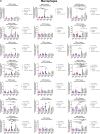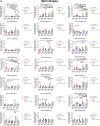Assessing Longitudinal Treatment Efficacies and Alterations in Molecular Markers Associated with Glutamatergic Signaling and Immune Checkpoint Inhibitors in a Spontaneous Melanoma Mouse Model
- PMID: 38445232
- PMCID: PMC10914525
- DOI: 10.1016/j.xjidi.2024.100262
Assessing Longitudinal Treatment Efficacies and Alterations in Molecular Markers Associated with Glutamatergic Signaling and Immune Checkpoint Inhibitors in a Spontaneous Melanoma Mouse Model
Abstract
Previous work done by our laboratory described the use of an immunocompetent spontaneous melanoma-prone mouse model, TGS (TG-3/SKH-1), to evaluate treatment outcomes using inhibitors of glutamatergic signaling and immune checkpoint for 18 weeks. We showed a significant therapeutic efficacy with a notable sex-biased response in male mice. In this follow-up 18-week study, the dose of the glutamatergic signaling inhibitor was increased (from 1.7 mg/kg to 25 mg/kg), which resulted in improved responses in female mice but not male mice. The greatest reduction in tumor progression was observed in male mice treated with single-agent troriluzole and anti-PD-1. Furthermore, a randomly selected group of mice was removed from treatment after 18 weeks and maintained for up to an additional 48 weeks demonstrating the utility of the TGS mouse model to perform a ≥1-year preclinical therapeutic study in a physiologically relevant tumor-host environment. Digital spatial imaging analyses were performed in tumors and tumor microenvironments across treatment modalities using antibody panels for immune cell types and immune cell activation. The results suggest that immune cell populations and cytotoxic activities of T cells play critical roles in treatment responses in these mice. Examination of a group of molecular protein markers based on the proposed mechanisms of action of inhibitors of glutamatergic signaling and immune checkpoint showed that alterations in expression levels of xCT, γ-H2AX, EAAT2, PD-L1, and PD-1 are likely associated with the loss of treatment responses. These results suggest the importance of tracking changes in molecular markers associated with the mechanism of action of therapeutics over the course of a longitudinal preclinical therapeutic study in spatial and temporal manners.
Keywords: Cancer biology; Drug development; Melanoma; Methods/tools/techniques; Mouse models.
© 2024 The Authors.
Figures
















Similar articles
-
A Spontaneous Melanoma Mouse Model Applicable for a Longitudinal Chemotherapy and Immunotherapy Study.J Invest Dermatol. 2023 Oct;143(10):2007-2018.e6. doi: 10.1016/j.jid.2023.03.1664. Epub 2023 Mar 29. J Invest Dermatol. 2023. PMID: 36997110 Free PMC article.
-
Glucocorticoid activation by HSD11B1 limits T cell-driven interferon signaling and response to PD-1 blockade in melanoma.J Immunother Cancer. 2023 Apr 7;11(4):e004150. doi: 10.1136/jitc-2021-004150. J Immunother Cancer. 2023. PMID: 37028818 Free PMC article.
-
The Next Immune-Checkpoint Inhibitors: PD-1/PD-L1 Blockade in Melanoma.Clin Ther. 2015 Apr 1;37(4):764-82. doi: 10.1016/j.clinthera.2015.02.018. Epub 2015 Mar 29. Clin Ther. 2015. PMID: 25823918 Free PMC article. Review.
-
Synergistic anti-tumor efficacy of a hollow mesoporous silica-based cancer vaccine and an immune checkpoint inhibitor at the local site.Acta Biomater. 2022 Jun;145:235-245. doi: 10.1016/j.actbio.2022.04.001. Epub 2022 Apr 7. Acta Biomater. 2022. PMID: 35398544
-
Histone Deacetylase Inhibitors to Overcome Resistance to Targeted and Immuno Therapy in Metastatic Melanoma.Front Cell Dev Biol. 2020 Jun 17;8:486. doi: 10.3389/fcell.2020.00486. eCollection 2020. Front Cell Dev Biol. 2020. PMID: 32626712 Free PMC article. Review.
Cited by
-
Current State of Melanoma Therapy and Next Steps: Battling Therapeutic Resistance.Cancers (Basel). 2024 Apr 19;16(8):1571. doi: 10.3390/cancers16081571. Cancers (Basel). 2024. PMID: 38672652 Free PMC article. Review.
References
-
- Barr J.T., Tran T.B., Rock B.M., Wahlstrom J.L., Dahal U.P. Strain-dependent variability of early discovery small molecule pharmacokinetics in mice: does strain matter? Drug Metab Dispos. 2020;48:613–621. - PubMed
Grants and funding
LinkOut - more resources
Full Text Sources
Research Materials
Miscellaneous

